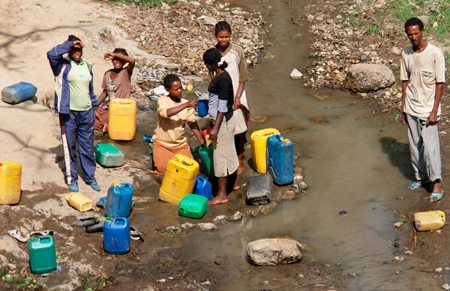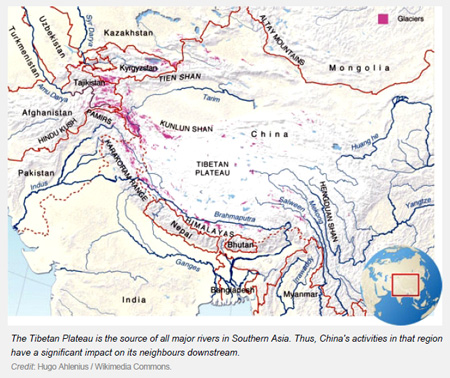
Photo Credit: iStockphoto.com
River water sharing has been a source of both cooperation and conflict since time immemorial. According to a UN survey, "out of 200 international rivers, 70 percent of them are being shared by two countries" and over 1,000 water sharing treaties have been signed in the last 50 years.
Environmental change and the future of water (in)security
Climate change is affecting the geophysical features of the Tibetan Plateau. Glacial retreat is being accelerated by rising temperatures, and seasonal snow cover is decreasing in length. According to the China Meteorological Administration, Tibet Province has had an average rise of 0.32 degrees Celsius every decade since records began in 1961, much higher than the national average rise of 0.05–0.08 degrees Celsius. The warming could, it has been argued, lead to the swelling of Tibetan lakes and increased runoff during the summers, and downstream areas could face floods in the short term and droughts in the long term.
Compounding the impacts of environmental change are factors such as overuse, pollution and poor management, all of which have affected rivers, and thus water availability, in the region. According to a study, "[w]ater availability on per capita cubic metre basis is estimated to decline from 2150 at present to 1860 in 2030 in case of China, from 1730 to 1240 in case of India, from 7320 to 5700 in case of Bangladesh, from 8500 to 5500 in case of Nepal".
The looming environmental threat of China's moves
The security of the almost 2 billion people residing in South and Southeast Asia would be threatened if the water resources of the Tibetan Plateau are altered. Yet, China's activities on the plateau such as constructing dams, cutting down forests and mining could do just that.
China's dams on the Tibetan Plateau
One of the characteristics of China's policy has been its endeavour to manipulate natural environments in pursuit of national goals. Through extensive dam building, China is already home to half of the world's roughly 50,000 large dams, with more to come. However, the construction of dams has important environmental consequences for rivers. China's Three Gorges Dam has been held responsible for worsening water pollution due to river depletion, sedimentation and increasing eutrophication.
In the Tibetan Plateau, China has been increasingly diverting river water for different purposes--electricity generation, irrigation, mining and other economic activities. Take the case of River Brahmaputra. Approximately, 354 billion cubic metres of waters flow from Tibet to India. Out of that, 131 billion cubic metres is accounted for in the Brahmaputra; and on this river alone, China is planning to build 28 dams. China is planning to build the world's largest dam and hydropower station on the Brahmaputra at the Great Bend.
India would not be the only country to experience the negative impacts of China's dams. Bangladesh would be affected by China's diversion of waters during the dry seasons, and perhaps also during monsoons when it would be vulnerable to greater flooding. Pakistan could also become a victim of China's damming strategy, as geography dictates that developments in Tibet that reduces the flow of the Indus (and its tributaries) would have carryon effects for Pakistan.

Deforestation and mining on the Tibetan Plateau
In addition to dam building, deforestation and mining operations have also started to affect both the quantity and quality of water, particularly in the lower riparian countries. One study asserts that deforestation "would lead to decreased transpiration and increased summer precipitation in the deforested area and a wetter and warmer climate on the Tibetan Plateau in summer. This may produce more runoff into the rivers originating from the Tibetan Plateau and worsen flooding disasters in the downstream areas".
These circumstances arising from upstream activities on the Tibetan Plateau make the role of negotiations essential, and the need for strengthening existing river water sharing arrangements and fostering new ones paramount.
Where does China stand on cooperation"FONT-SIZE: medium">Conclusion
It is apparent from the above that current river water sharing arrangements in the region are inadequate when it comes to tackling the emerging problems brought about by environmental change and China’s activities in Tibet.
Unfortunately, prospects for significant progress on the bilateral or multilateral fronts do not seem promising. Ideally, with water security emerging as a critical issue in India and Pakistan, the two countries should work towards integrated basin management.
However, the historical baggage between the two countries and the inappropriate premises of the Indus Waters Treaty (which were based on partition) have ensured that meaningful levels of cooperation on joint projects are improbable at present. This is also the case with India and Bangladesh, where lack of political will and prevailing domestic politics have led to further avenues of cooperation being shelved. In the case of China, it does not at this stage have any incentive to enter into agreements with its neighbouring countries.
Nevertheless, with environmental change set to reshape the dynamics of river water sharing in Southern Asia, countries need to place greater priority on engaging with each other and finding new pathways for cooperation in order to ensure sustained water security in countries and for populations in the region, and to prevent an escalation of socioeconomic, resource and political tensions in the already politically volatile region.
There is also a clear need for the current treaties to be revised, and further, for regional frameworks to be bolstered to tackle the challenges stemming from environmental change.

This is an extract from the original article, reposted with permission from the Centre for Non-Traditional Security (NTS) Studies, S Rajaratnam School of International Studies (RSIS). Dhanasree Jayaram is Research Associate (Environment and Energy Programme) with the Centre for Air Power Studies in New Delhi, India.
BY : Dhanasree Jayaram, RSIS